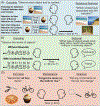Back to the future: Progressing memory research in eating disorders
- PMID: 37594119
- PMCID: PMC10843822
- DOI: 10.1002/eat.24045
Back to the future: Progressing memory research in eating disorders
Abstract
Objective: Human behaviors, thoughts, and emotions are guided by memories of the past. Thus, there can be little doubt that memory plays a fundamental role in the behaviors (e.g., binging), thoughts (e.g., body-image concerns), and emotions (e.g., guilt) that characterize eating disorders (EDs). Although a growing body of research has begun to investigate the role of memory in EDs, this literature is limited in numerous ways and has yet to be integrated into an overarching framework.
Methods: In the present article, we provide an operational framework for characterizing different domains of memory, briefly review existing ED memory research within this framework, and highlight crucial gaps in the literature.
Results: We distinguish between three domains of memory-episodic, procedural, and working-which differ based on functional attributes and underlying neural systems. Most recent ED memory research has focused on procedural memory broadly defined (e.g., reinforcement learning), and findings within all three memory domains are highly mixed. Further, few studies have attempted to assess these different domains simultaneously, though most behavior is achieved through coordination and competition between memory systems. We, therefore, offer recommendations for how to move ED research forward within each domain of memory and how to study the interactions between memory systems, using illustrative examples from other areas of basic and clinical research.
Discussion: A stronger and more integrated understanding of the mechanisms that connect memory of past experiences to present ED behavior may yield more comprehensive theoretical models of EDs that guide novel treatment approaches.
Public significance: Memories of previous eating-related experiences may contribute to the onset and maintenance of eating disorders (EDs). However, research on the role of memory in EDs is limited, and distinct domains of ED memory research are rarely connected. We, therefore, offer a framework for organizing, progressing, and integrating ED memory research, to provide a better foundation for improving ED treatment and intervention going forward.
Keywords: anorexia; associative learning; binge-eating; bulimia; eating disorders; episodic memory; learning; memory; procedural memory; working memory.
© 2023 Wiley Periodicals LLC.
Conflict of interest statement
CONFLICT OF INTEREST STATEMENT
The authors have no conflicts of interest to disclose.
Figures





References
-
- Addis DR, & Tanguay A (2022). Prospective cognition and its links with memory. In Kahana M & Wagner AD (Eds.), Oxford handbook on human memory. Oxford University Press. 10.31234/OSF.IO/W69ND - DOI
-
- American Psychiatric Association. (2013). Diagnostic and statistical manual of mental disorders (5th ed.). 10.1176/appi.books.9780890425596 - DOI
Publication types
MeSH terms
Grants and funding
LinkOut - more resources
Full Text Sources
Medical
Miscellaneous

